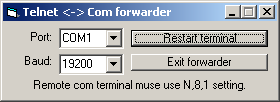Mike Chambers
Veteran Member
- Joined
- Sep 2, 2006
- Messages
- 2,621
if anybody is interested, last night i threw together a little windows app that lets you connect to telnet servers and it forwards through a serial com port via null modem. i just wanted to write it for the true "retro feel" when i connect to BBSes...
i have the null modem connected to my 8088 and i'm running the old term program Procomm Plus on it.
here's a screenshot to give you an idea of what it looks like... nothing special (i spent just like an hour and a half on it), but it is pretty cool to get on a telnet BBS with a real oldschool term proggie

here's a download link: http://rubbermallet.org/teln2com.zip
if you don't have MSVBVM60.DLL you'll have to download it: http://rubbermallet.org/msvbvm60.dll
it needs to be either in the dir with the other teln2com files or in WINDOWS\SYSTEM32
you need to have the terminal app already up on the client machine, and then click the "Restart terminal" button. you will be prompted via the terminal for the telnet server's host address and port.
let me know how it works for you if you try it!
NOTE: if you start geting garbage and dropped data, it means your client terminal is too dang slow... on a 4.77 MHz 8088, i start getting garbage if i begin to go over about 19200 baud. all you have to do is drop the baud until you stop getting garbage. i just keep it at 9600, and i have no problems.
i have the null modem connected to my 8088 and i'm running the old term program Procomm Plus on it.
here's a screenshot to give you an idea of what it looks like... nothing special (i spent just like an hour and a half on it), but it is pretty cool to get on a telnet BBS with a real oldschool term proggie

here's a download link: http://rubbermallet.org/teln2com.zip
if you don't have MSVBVM60.DLL you'll have to download it: http://rubbermallet.org/msvbvm60.dll
it needs to be either in the dir with the other teln2com files or in WINDOWS\SYSTEM32
you need to have the terminal app already up on the client machine, and then click the "Restart terminal" button. you will be prompted via the terminal for the telnet server's host address and port.
let me know how it works for you if you try it!
NOTE: if you start geting garbage and dropped data, it means your client terminal is too dang slow... on a 4.77 MHz 8088, i start getting garbage if i begin to go over about 19200 baud. all you have to do is drop the baud until you stop getting garbage. i just keep it at 9600, and i have no problems.
Last edited:
